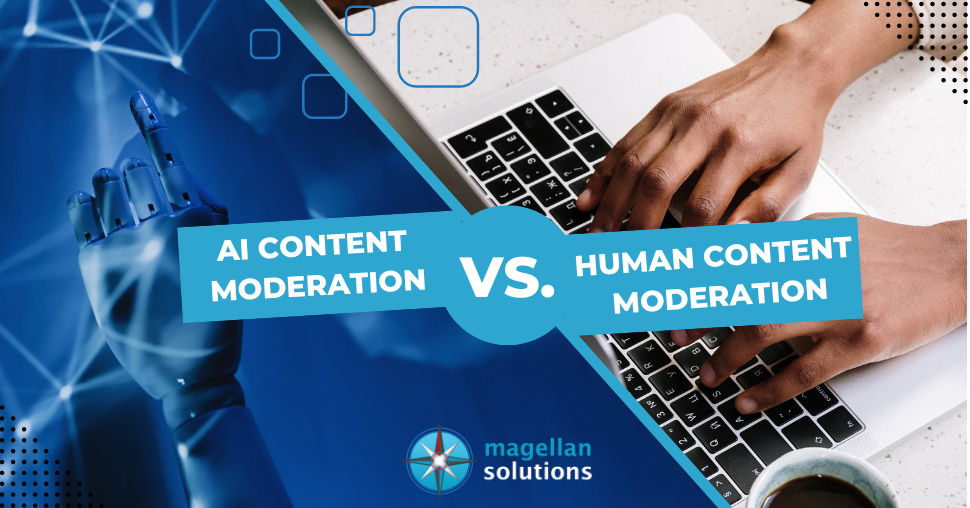Schedule a FREE call with our outsourcing expert now and get a precise quotation that meets your requirements. Don't wait - get started today!
AI Content Moderation vs. Human Content Moderation: Which is Better?
How do platforms like Facebook, Instagram, Twitter, Google, YouTube, and other social media platforms process millions of posts, comments, videos, and photographs sent to their websites daily? It requires collaboration between automated and human content moderators.
User-generated content (UGC) constantly changes the game’s rules for a company’s growth strategies, forcing companies to adopt content moderation to control all the information posted about their brand.
This article will discuss the difference between artificial intelligence (AI) content moderation and human content moderation. We will also talk about the benefits and drawbacks of both.
AUTOMATED MODERATION MEANING
AI content moderation speeds up the process of assessing every content, which makes it crucial in a pool of UGC that is constantly expanding. By using automated moderation, blocking users’ IP addresses flagged as abusive is also possible.
AI content moderation is achievable with algorithms, built-in knowledge bases, natural language processing, and computer vision.
HUMAN CONTENT MODERATION, MEANING
Human content moderation is manually monitoring and screening user-generated information and removing content that is fraudulent, offensive, illegal, scam, or otherwise violating the rules.
Automated tools cannot judge full-scale datasets and make content-specific judgments; human content moderation is essential to sort through this subjectivity.
DIFFERENCE BETWEEN AI CONTENT MODERATION & HUMAN CONTENT MODERATION
Let’s get into more detail about how AI and human content moderation differ:
Cost-effectiveness
It would be best if you had a lot of human moderators because a lot of data must be moderated to accomplish a large amount of work. More employees mean a more extensive staff which entails more payroll expenses.
However, the cost of AI content moderation varies depending on your organization’s requirements. The price of AI software relies on various variables, including your company’s preferences and the kind of AI necessary for particular tasks.
Accurate Content
When assessing texts, many subtle differences in the content require critical comprehension to decide whether it is allowed.
It is tough to analyze human speech because it has many meanings. Automation technologies are only partially reliable at locating content across linguistic categories.
AI content moderation can regulate content faster than a person could. It can complete repetitive moderation jobs in shorter amounts of time, making it the perfect tool for categorizing large amounts of content.
However, human moderators can better preserve the accuracy of content regulation when it pertains to subjective ideas.
Quality of Moderation
In addition to the daily increase in UGC, the excessively inappropriate topics that are frequently noted among it may put a strain on human workers and degrade the effectiveness of content control.
In this case, the logical answer would be automated content moderation, which can handle a significant portion of the process. It protects human moderators from exposure to and taking in the most offensive stuff.
HOW AI CAN HELP IN CONTENT MODERATION? WHY DO WE NEED IT?
Since it helps produce and sustain a product that is then sold to customers, AI content moderation is a significant accomplishment in the history of social media management. Automated content moderation is incorporated into business plans, helping increase user engagement and define brand identity.
Here are the following advantages of AI content moderation:
Content Filtering & Automation
Given the enormous amount of UGC, manually editing material becomes difficult and calls for scalable solutions. AI content moderation can automatically scan words, images, and videos for harmful material. Additionally, AI content moderation may categorize and filter content deemed improper in a particular situation and aid in preventing its posting, supporting human moderators in the content review process and assisting brands in maintaining the quality and safety of their content.
Reduced Exposure to Dangerous Content
Human moderators have to deal with controversial content. And people who think their decisions are biased often question their ability to help. Moderation is hard for people to do. The fact that they have to filter out so much bad stuff could negatively affect their mental health.
AI can help human moderators by sorting out questionable content for human review. This saves content moderation teams time and effort going through user-reported content. AI content moderation can also make humans more productive. This is by making it easier for them to manage online content faster, more accurately, and without making mistakes.
Speed & Scalability
By 2025, the World Economic Forum predicts that humans will produce 463 exabytes of data per day, equivalent to more than 200 million DVDs daily. Humans are unlikely to be able to keep up with the amount of UGC that is available.
Conversely, AI content moderation can offer scalable data handling across several real-time channels. Regarding the sheer amount and volume of UGC, it can scan and detect; AI content moderation can outperform humans. AI can scale on demand and quickly analyze massive volumes of data regarding content control.
Monitoring Real-Time Content
Moderating real-time UGC data is essential to maintaining your platform’s user experience safety. The AI-enabled solution aids automated content moderation systems by instantaneously identifying the type of content and flagging it before publication. One benefit is that it protects the platform from harmful and malicious information that may otherwise disturb users’ thoughts.
Pre-moderation Enhancement
AI content moderation has a significant impact on how pre-moderation works. Context-based moderation and content-based moderation are the two components of the procedure. AI modifies text using a variety of objects, including sentiment analysis, word matching, word embedding, natural language processing (NLP) classifiers, and others.
AI CONTENT MODERATION PROBLEMS
While it generally works out well, there are challenges in AI content moderation. Let’s talk about AI content moderation problems.
Bias in the Creator & Dataset
Bias in automated technologies is one of the main issues with algorithmic decision-making in various businesses. Automated technologies that make decisions, including in the context of content moderation, can further stigmatize and silage already disproportionately subjected populations both online and offline. Therefore, such automated methods should be kept to a minimum when making decisions.
Importance of Context
Machine learning technology doesn’t consider a post’s context. Which is often what makes it illegal or against a content policy. Some data, like the sender and recipient of a message, could be used by a machine learning tool. But this could not be good for your privacy. Using technology to figure out other kinds of contexts is much more complicated.
Accuracy
The sort of information a tool is trained to identify and eliminate significantly influences how accurately it can do so. Smaller sites may rely on commercially available automated techniques. However, the accuracy of these systems in locating information across several platforms is limited.
Accountability & Transparency
The inherent lack of transparency surrounding algorithmic decision-making is one of the main issues with using automated solutions in the content moderation space. Because nothing is known about how these algorithms are constructed, what datasets they are trained on, how they find connections and make choices, and how trustworthy and accurate they are, they are frequently called “black boxes.”
Algorithms don’t have “critical reflection,” unlike humans. Researchers cannot determine how the algorithm creates the associations it detects when using black-box machine learning systems. Currently, several internet platforms only disclose a small portion of their methods to find and delete information using automated algorithms.
Understanding Human Speech in Context
The limited capacity of technology to understand contextual changes in speech, visuals, and overall cultural standards presents another barrier to automated content moderation. Using specific terms or slang expressions in one place may be okay while finding them offensive in another. For automated platforms, subtleties and variances in language and behavior could also be challenging to detect. The use of images in context can be challenging at times.
However, because content moderation is fundamentally subjective and human speech is not objective, this technology is constrained because it cannot recognize human speech’s complexities and contextual differences.
Flexible & Dynamic Models are Essential
Flexible and dynamic models are needed because human communication patterns change quickly, and speakers barred by automated filters have an added motivation to figure out how to bypass the filter. Machine learning algorithms that are static and unable to classify user communications effectively will quickly become obsolete.
The Distinction of the Domain
NLP software performs best. Building tools that function in various contexts, languages, cultures, interest groups, and topic areas is challenging.
A Bias Introduced by an Annotation Could Affect Supervised Learning
Many people are typically involved in labeling a dataset for supervised learning, reviewing samples and selecting the appropriate label, or assessing an automatically applied label. Understanding the consistency of performance across various labelers of a dataset using intercoder reliability is crucial. Low intercoder reliability demonstrates that the humans deciding whether the information is categorized as “hate speech” or “spam” disagree.
CONCLUSION
It gets more challenging for businesses to keep up with the need to check the information before it goes live. One efficient answer to this expanding problem is AI content moderation.
However, the widespread usage of AI is concerning. It has been discovered that many of these automatic systems are erroneous, this is partially due to the lack of diversity in the training samples used to train algorithmic models.
Rather than serving to replace humans, AI content moderation performs best as a tool. AI cannot completely replace people, especially in this field.
The best results can be achieved by businesses combining these two. Both approaches can create an operational framework that enables companies to get the most excellent moderating outcomes in the online world.
Magellan Solutions Can Provide a Quality Service for Your Content Moderation Needs
Make a difference for your company and achieve the outcomes you’ve always desired.
Suppose you are looking for a content moderator in the Philippines. In that case, Magellan Solutions will undoubtedly assist you with your business goals and objectives at a significantly reduced cost without sacrificing quality.
With 18 years of expertise in the field, we take great pride in offering only the best call center services. On top of that, we are an ISO-certified and HIPAA-compliant outsourcing company. We provide a great variety of top-notch outsourced business solutions.
Contact us now, and let us assist you with your business needs.














